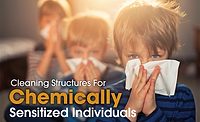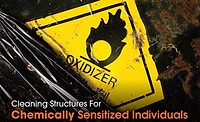Cleaning Structures for Chemically Sensitized Individuals | Part 1

Know What You Are Getting Into
As will be explained in greater detail, cleaning and restoration professionals are increasingly being faced with the challenge of responding to situations where chemically sensitive individuals are involved. While many professionals have some experience with individuals sensitive to specific contaminants like mold or spray-foam insulation, there is little documentation directed toward this industry that deals in a comprehensive way with the challenges of people who may have a low tolerance for chemicals as well as specific contaminants.
This article is the first of a five part series that discusses how to clean and restore buildings that are/will be occupied by sensitized individuals. This kick off provides a foundation for the entire series by offering science-based evidence regarding the basis and extent of the issues related to chemically sensitized individuals. Subsequent parts will focus on the specific cleaning techniques of source removal, neutralization, off-gassing, and oxidation (see illustration 1).
At this point a word of warning is in order. This series contains a large number of references to particular products and processes. This specificity is intentional and based on the author’s experience with a wide range of products and vendors; as well as wisdom gleaned from contractors through hundreds of classes and projects. Hopefully, these tacit endorsements will help professionals make better choices when deciding how to address specific situations. Of course, it comes with the risk of unintentionally offending the makers of competing products or technologies with which I am not yet familiar. My contact information is shared at the end of each part of this series to allow individuals to offer such information, if desired.

Cleaning techniques for chemically sensitized occupants.
What is critical to emphasize in regards to the named items is that the author does not have a direct financial interest (i.e., sales commissions, distribution fee, etc.) in any of the products or processes discussed in this series. It is a point of professional pride to learn about as many potentially relevant technologies as possible. Over three decades in the industry, Wonder Makers has provided consulting services to many of the organizations that offer products to the industry, including some mentioned in this series, so this disclaimer is important for readers to keep in mind as they move through the material.
Why Is This Subject Important?
If a cleaning or restoration professional has not yet dealt with one of the growing groups of people who are sensitive to chemical or biological contaminants, odds are that they soon will have a project with that sort of additional challenge. One of the difficulties is that there are still a number of different terms used to identify the physical conditions associated with sensitivity. Two of the most common descriptors applied to such people are individuals with “chemical intolerance” (CI) or “multiple chemical sensitivity (MCS). What ties the terms together is a definition which typically is described in medical documents as:
Persons report feeling ill in multiple physiological systems from low levels of a wide range of chemically unrelated environmental substances.
One of the key words in the above description is “physiological”. This drives home the point that, despite many unsupported stories to the contrary, chemical sensitivity is not just psychological. In other words, it is not all just in their heads.
As the medical community continues research into this field, the focus has turned to the question about what role a person’s genetic make-up plays in their likelihood of becoming chemically sensitized. Depending on which study is reviewed, the data indicates that 15-30% of the general population are highly “sensitizable”. The researchers come to these numbers by evaluating large groups of people and measuring their heart rate, blood pressure, and immune system allergic response markers. An interesting sidebar to the sensitization research was the realization that individuals who are sensitizable are more likely to be diagnosed with Chronic Fatigue Syndrome (CFS), Chronic Fibromyalgia (CF), Chronic Inflammatory Response Syndrome (CIRS), and other previously mysterious maladies.
What is clear is that in addition to genetics, certain other factors play a role in chemical sensitivity. Gender is one key factor with nearly 2/3 of all medically diagnosed cases of chemical sensitivity being females. A family history of one or both parents being sensitized means that any children will have a significantly greater chance of becoming chemically sensitized as well. Finally, a parent’s alcohol use, particularly a mother-to-be who abuses alcohol during pregnancy, is more likely to bear a child who grows up to be chemically sensitized than other children.
Acute Or Chronic Exposures; It Is Still Chemicals
This research into susceptibility is starting to answer some lingering questions in the field of chemical sensitization. Many cases have demonstrated that a big “trigger event”, such as exposure to a chemical as a result of an accidental release, will cause chemical sensitization in a very large percentage of the exposed population. But, even in that sort of scenario only a portion of the people exposed will develop any long term sensitivity to the initial chemical or a broader range of chemicals. The distinctions in individuals developing a reaction are even more pronounced if the trigger event is a chronic situation, one where the exposure happens a little at a time over a period of weeks or months.
Of course, the primary cause of chemical sensitivity is exposure to chemicals. However, controlling chemical exposure, especially for children, is increasingly difficult because more chemicals are being added to our lives every day. Some of the main sources of chemical exposure include off-gassing from building products, use of personal care items, building contents and furnishings, packaging supplies, food, and residual chemical contamination in our indoor and outdoor environment.
Compared to 40 or 50 years ago, most people have dramatically increased their exposure to chemicals. It is not just that people tend to spend more time indoors, a big factor is that buildings are constructed to be more air tight. In addition to increased energy efficiency, that trend of tighter buildings trap more of the chemicals that are off-gassed. It also means that there is less dilution of small particles that are created during daily life activities and cleaning.
Cleaning To Address All The Chemical Transport Mechanisms
The simple reality is that dust and chemicals are present in our buildings. Contractors wishing to help individuals with chemical sensitivities by conducting specialized cleaning, or those who want to avoid problems by properly cleaning after a restoration activity, have to address both the chemicals and the dust. Modern house dust has a significant percentage of chemical solids as part of its makeup. In addition, many of the other dust particles, particularly those that are fibrous, absorb vaporous chemicals. That is why source removal, including the removal of residual built up dust, is key to addressing the concerns of chemically sensitized building occupants.
Cleaning and restoration professionals that want to protect and grow their businesses need to recognize that the number of chemicals and chemically sensitized people found in buildings are both growing at a significant rate. This is not a good combination. The frequency with which individuals are experiencing adverse reactions to chemicals is obvious evidence that there is a growing group which cannot tolerate the “normal” chemical load in today’s modern buildings. In those situations, the contaminants must either be cleaned or neutralized in order to protect or facilitate recovery of their health. Professionals in the cleaning and restoration industry can certainly rise to this challenge if they just take a few minutes to understand the needs of these potential clients and review their work procedures with the goal to properly service all of their customers, even if they are chemically sensitizable.
Looking for a reprint of this article?
From high-res PDFs to custom plaques, order your copy today!







